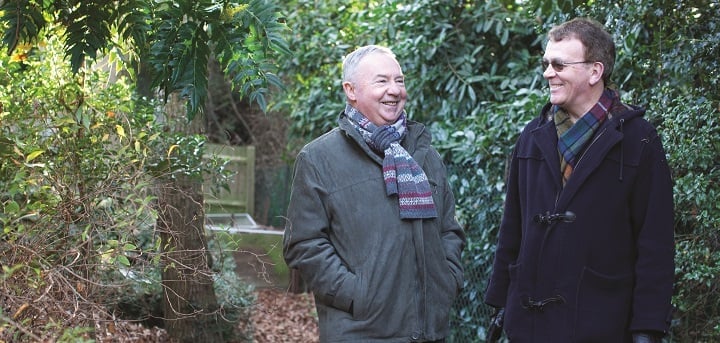The Benefits of Park Walking

COVID-19 Update: The Government has asked everyone to stop non-essential contact with others and non-essential travel, which is also known as social distancing. This measure aims to reduce close contact with others.
The Government is strongly advising anyone over the age of 70 (regardless of how well they are) people with underlying conditions and pregnant women to strictly adhere to the guidance on social distancing for the next 12 weeks. This is to reduce the risk of contracting coronavirus and experiencing severe illness from it.
This means you should avoid crowds and places where you are likely to come into close contact with others (within 2 metres). This includes public transport, large gatherings and events, and ‘closed areas’ such as pubs, restaurants and cafes. It also means avoiding gatherings with family and friends and ‘non-essential’ visitors to your home.
It does not mean you have to remain at home 24/7, but rather take care to go out at times and to places when you are unlikely to come into close contact with others.
For more information please click here.
There is now overwhelming evidence that regular physical activity, including walking, is one of the best things anyone can do to keep healthy. Also, that spending time in green spaces such as parks and woodlands is good for our mental and physical health.
There is also increasing evidence that spending time in green spaces such as parks and woodlands is good for our mental health, as well as our physical health. Reseach shows that walking in green spaces has far greater benefits for older people's physical health than walking alongside busy roads, where air pollution can actually reverse the beneficial effects of walking!
A Lancet study in November 2019 reported that those participants who walked in parks all showed increased beneficial effects regarding the function of their arteries from walking as opposed to those who strolled down busy streets.
The Benefits of Walking:
Walking regularly at any speed will:
- Help manage weight
- Reduce the risk of type 2 diabetes
- Reduce risk of certain cancers such colon, breast and lung cancer
- Improve flexibility and strength of your joints, muscles and bones, and reduce the risk of osteoporosis
- Increase “good” cholesterol
- Boost your immune system
- Improve your mood, reduce anxiety, aid sleep and improve self-image
Managing and Recovering from Health Problems
Walking can help you to manage and recover from certain long term conditions (as part of a care plan supervised by your doctor). Many patients recovering from heart problems find walking is a good way to recover their strength gently and gradually. Walking can help manage the side effects of cancer treatment and even prevent certain cancers recurring.
Mental Health and Wellbeing
Walking improves mental wellbeing and helps fight stress and depression. Walking for Health provides opportunities for participants to meet new people and form new friendships. This is the top motivator for many participants. This social aspect of health walks also contributes to improving participants’ mental health.
A recognized barrier to physical activity is not having someone to get active with, and a key way of overcoming that is the opportunity to socialise and meet new people. There is also evidence that the social support relationships offered by group-based walking schemes help maintain increased levels of physical activity in the longer term.
Additional Benefits of Walking:
- Walking, like other physical activities, releases endorphins which improve mood and reduce stress and anxiety
- Feeling fitter and controlling weight helps improve your body image and confidence
- Active people have a reduced risk of clinical depression
- Walking in a group is a sociable activity that can help improve mental health and overcome feelings of isolation
- Spending time in the outdoors and in contact with the natural environment – for example by walking in parks, woodland and green spaces – can have a positive effect on mental health
- You can walk from your doorstep at a time that suits you
- You can use walking for everyday short journeys
- You don’t need to concentrate on walking itself, leaving you free to enjoy your surroundings, chat to friends, family or just relax
- You can enjoy a variety of surroundings as you walk in different places and different seasons
Walking and Everyday Life
For most people, walking is the easiest way to meet physical activity recommendations and fit into your everyday life. This is because walking is:
- Free and requires no special equipment, training, gym or club memberships
- Available to almost everyone
- Safe and low-impact, with a low risk of injuries and accidents
- Easy to start slowly and build up gradually
Scents of Parks and Woodlands may reduce Stress
A walk in a park or woodland with lots of trees may be the healthiest thing you can do. Scents and smells have a powerful effect on our health and emotions. It seems that smells are closely tied to the emotional center in our brain. This is why certain smells and scents can arouse a sense of nostalgia or other emotions relating to our past.
It’s never too late to get active!
Even people who take up physical activity late in life will benefit. One study found that previously inactive men who became active at the age of 50 were 49% more likely to survive to the age of 60 than men who had not previously exercised.
"If a medication existed which had a similar effect to physical activity [like walking], it would be regarded as a “wonder drug” or a “miracle cure”" (England’s Chief Medical Officer 2010).
